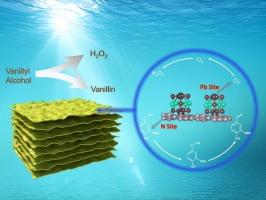双活性位CsPbBr3/多孔碳氮化合物s -方案异质结协同生产香兰素和过氧化氢
IF 13.2
1区 工程技术
Q1 ENGINEERING, CHEMICAL
引用次数: 0
摘要
尽管CsPbBr3和氮化碳异质结在光催化CO2还原方面显示出很大的前景,但它们在氧化驱动反应中的应用仍未得到很大的探索。利用CsPbBr3与多孔氮化碳纳米片(PCN)界面上的光生电子还原能力和良好的氧化能力,我们构建了由CsPbBr3和PCN组成的s -图式异质结。这种异质结系统能够在可见光照射下同时生产香兰素和过氧化氢。利用Pb和N各自的活性位点,该体系的香兰素产率为32.5 mM, H2O2产率为10 mM。合理设计的s型异质结通过内部电场增强电荷分离,同时在空间上分配PCN和CsPbBr3上的氧化和还原反应,提高了选择性和整体效率。机制研究表明,Pb和N位点在促进光催化活性中起重要作用。这项工作为有机转化和绿色氧化剂生产的整合提供了一个有前途的策略。此外,它还为设计可持续化学过程的多功能光催化剂提供了有价值的见解。本文章由计算机程序翻译,如有差异,请以英文原文为准。

Dual active sites based CsPbBr3/porous carbon nitrides S-scheme heterojunction for synergetic vanillin and hydrogen peroxide production
Although CsPbBr3 and carbon nitride heterojunctions show great promise in photocatalytic CO2 reduction, their application in oxidation-driven reactions remains largely unexplored. Inspired by the strong photogenerated electron reduction capabilities and the favorable oxidation ability of the photogenerated holes at the interfaces between CsPbBr3 and porous carbon nitride nanosheets (PCN), we construct an S-scheme heterojunction composed of CsPbBr3 and PCN. This heterojunction system enables the simultaneous production of vanillin and hydrogen peroxide under visible-light irradiation. Utilizing the respective Pb and N active sites, the system achieves yields of 32.5 mM for vanillin and 10 mM for H2O2. The rationally designed S-scheme heterojunction enhances charge separation via the internal electric field while spatially allocating oxidation and reduction reactions on PCN and CsPbBr3, improving selectivity and overall efficiency. Mechanism investigations indicate that the Pb and N sites play a significant role in facilitating photocatalytic activity. This work offers a promising strategy for integrating organic transformation and green oxidant production. Additionally, it provides valuable insights into designing multifunctional photocatalysts for sustainable chemical processes.
求助全文
通过发布文献求助,成功后即可免费获取论文全文。
去求助
来源期刊

Chemical Engineering Journal
工程技术-工程:化工
CiteScore
21.70
自引率
9.30%
发文量
6781
审稿时长
2.4 months
期刊介绍:
The Chemical Engineering Journal is an international research journal that invites contributions of original and novel fundamental research. It aims to provide an international platform for presenting original fundamental research, interpretative reviews, and discussions on new developments in chemical engineering. The journal welcomes papers that describe novel theory and its practical application, as well as those that demonstrate the transfer of techniques from other disciplines. It also welcomes reports on carefully conducted experimental work that is soundly interpreted. The main focus of the journal is on original and rigorous research results that have broad significance. The Catalysis section within the Chemical Engineering Journal focuses specifically on Experimental and Theoretical studies in the fields of heterogeneous catalysis, molecular catalysis, and biocatalysis. These studies have industrial impact on various sectors such as chemicals, energy, materials, foods, healthcare, and environmental protection.
 求助内容:
求助内容: 应助结果提醒方式:
应助结果提醒方式:


